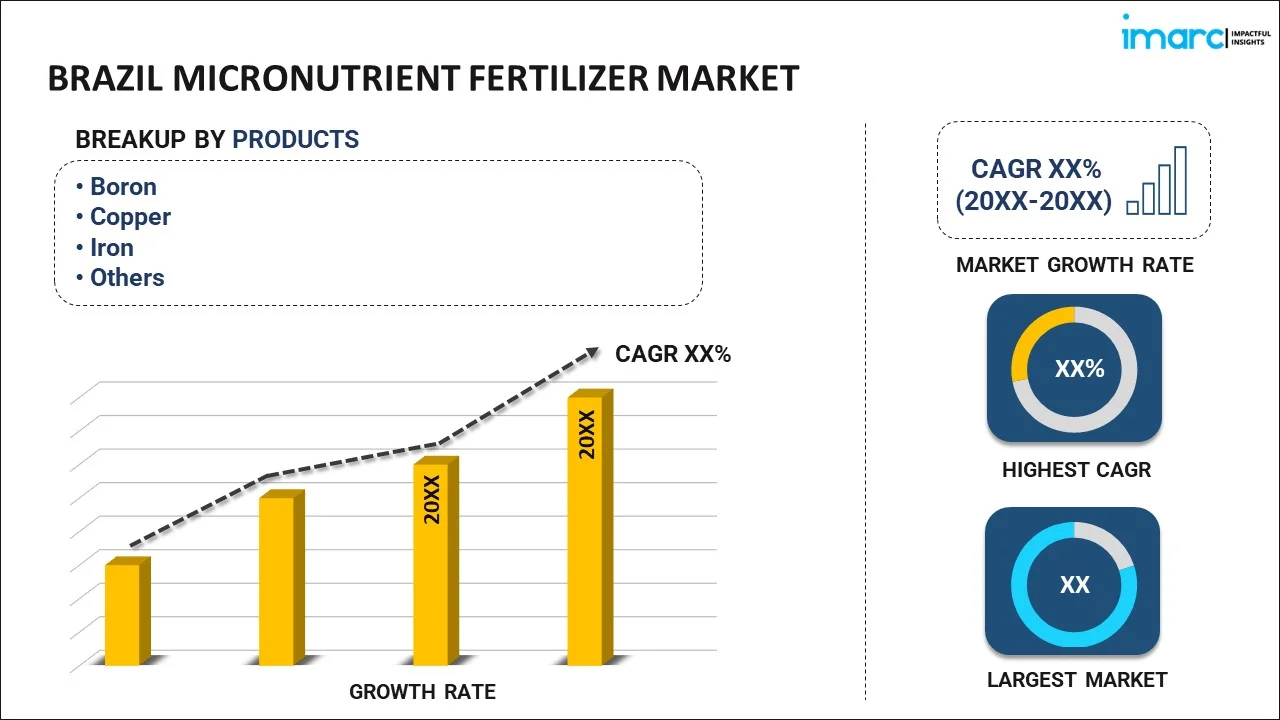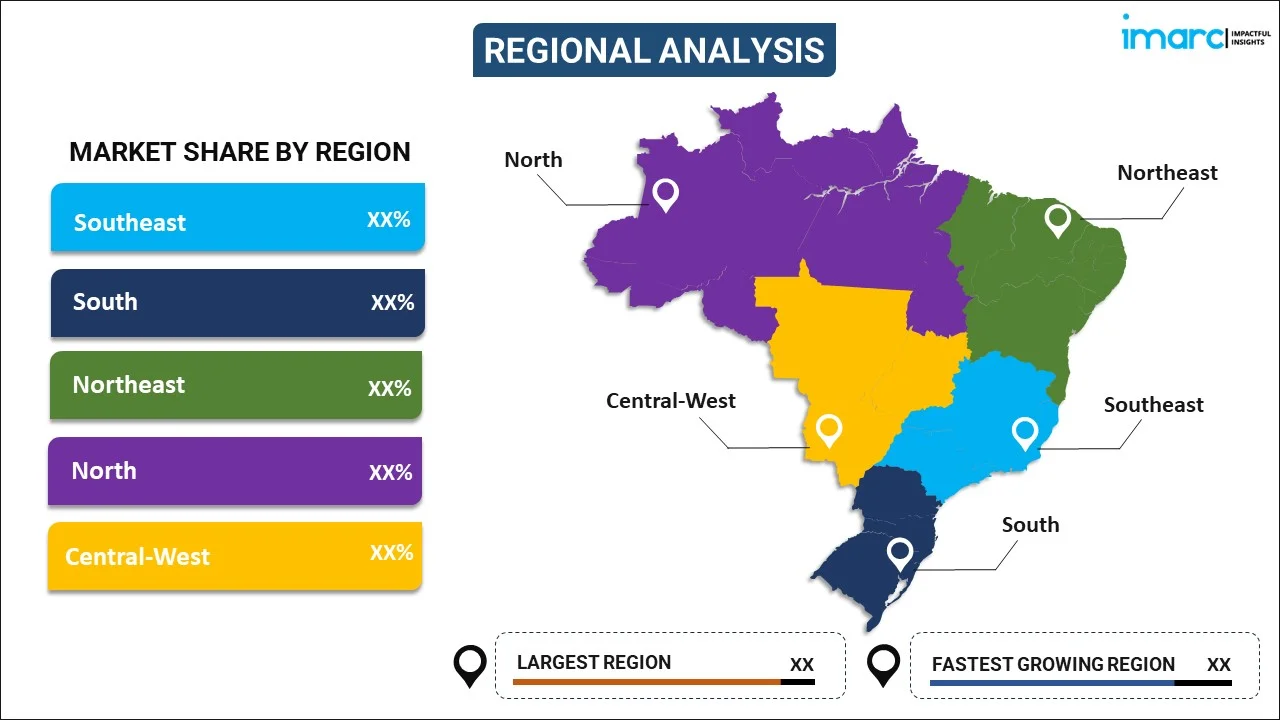
Brazil Micronutrient Fertilizer Market Report by Product (Boron, Copper, Iron, Manganese, Molybdenum, Zinc, and Others), Application Mode (Fertigation, Foliar, Soil), Crop Type (Field Crops, Horticultural Crops, Turf and Ornamental), and Region 2025-2033
Market Overview:
Brazil micronutrient fertilizer market size reached USD 121 Million in 2024. Looking forward, IMARC Group expects the market to reach USD 267 Million by 2033, exhibiting a growth rate (CAGR) of 9.2% during 2025-2033. The significant growth in the agriculture sector, increasing focus on sustainable practices, the implementation of favorable government initiatives, rapid technological advancements, rising awareness about crop nutrition, and availability of soil testing services represent some of the key factors driving the market.
|
Report Attribute
|
Key Statistics
|
|---|---|
|
Base Year
|
2024 |
|
Forecast Years
|
2025-2033
|
|
Historical Years
|
2019-2024
|
| Market Size in 2024 | USD 121 Million |
| Market Forecast in 2033 | USD 267 Million |
| Market Growth Rate (2025-2033) | 9.2% |
Micronutrient fertilizers refer to specialized fertilizing agents that provide essential nutrients to crops in trace amounts. They include elements such as zinc, iron, manganese, copper, boron, molybdenum, and chlorine. Micronutrient fertilizers are manufactured using synthetic chelates, mineral salts, and organic complexes. They are available in various forms, including granular, liquid, and powdered. Micronutrient fertilizers are utilized in agricultural fields, horticulture, home gardens, forestry, and aquaculture. They aid in enhancing crop yield, improving the nutritional quality of produce, and increasing plant resistance to diseases. Micronutrient fertilizers also contribute to soil health, improve water-use efficiency, and can be integrated easily into existing fertilization programs. Moreover, they offer key advantages, such as eco-friendliness, cost-effectiveness, quick absorption, and compatibility with other soil amendments and fertilizers.
Brazil Micronutrient Fertilizer Market Trends:
The expanding agriculture sector and the increasing need for efficient and sustainable farming methods in the country are major factors contributing to the market growth. In line with this, the widespread adoption of micronutrient fertilizers that balance essential elements, leading to higher yields and superior-quality produce, is favoring the market growth. Additionally, the increasing focus on sustainable agricultural practices in Brazil facilitating product adoption owing to their minimal environmental impact is strengthening the market growth. Moreover, the implementation of favorable government initiatives, such as financial incentives and tax reductions, is further bolstering the market growth. Along with this, rapid technological advancements in fertilizer manufacturing techniques, allowing for precise nutrient compositions and optimizing crop health, are positively impacting the market growth. In line with this, the introduction of controlled-release and nanotechnology-based micronutrient fertilizers, facilitating improved efficiency and cost-effectiveness, is fueling the market growth. Apart from this, the rising awareness among farmers about the importance of balanced nutrition for crops through various educational programs is providing a thrust to the market growth. In confluence with this, the widespread availability of soil testing services, educating and encouraging farmers to opt for nutrient-specific fertilization plans, is stimulating the market growth. Furthermore, the growing trade relationships and agricultural export commitments of Brazil with other nations, necessitating high crop productivity and quality, are boosting the market growth. Additionally, the ongoing development of novel formulations with customized blends of nutrients, offering farmers targeted solutions for nutrient management, is providing an impetus to the market growth. In line with this, the increasing utilization of digital tools, like nutrient mapping and remote sensing technologies, for better resource allocation is anticipated to drive the market growth. In addition to this, rapid growth in related sectors like livestock farming, which utilizes feed grains requiring nutrient-rich soils, is providing lucrative growth opportunities for the market.
Brazil Micronutrient Fertilizer Market Segmentation:
IMARC Group provides an analysis of the key trends in each segment of the market, along with forecasts at the country level for 2025-2033. Our report has categorized the market based on product, application mode, and crop type.
Product Insights:

- Boron
- Copper
- Iron
- Manganese
- Molybdenum
- Zinc
- Others
The report has provided a detailed breakup and analysis of the market based on the product. This includes boron, copper, iron, manganese, molybdenum, zinc, and others.
Application Mode Insights:
- Fertigation
- Foliar
- Soil
A detailed breakup and analysis of the market based on the application mode have also been provided in the report. This includes fertigation, foliar, and soil.
Crop Type Insights:
- Field Crops
- Horticultural Crops
- Turf and Ornamental
The report has provided a detailed breakup and analysis of the market based on the crop type. This includes field crops, horticultural crops, and turf and ornamental.
Regional Insights:

- Southeast
- South
- Northeast
- North
- Central-West
The report has also provided a comprehensive analysis of all the major regional markets, which include Southeast, South, Northeast, North, and Central-West.
Competitive Landscape:
The market research report has also provided a comprehensive analysis of the competitive landscape in the market. Competitive analysis such as market structure, key player positioning, top winning strategies, competitive dashboard, and company evaluation quadrant has been covered in the report. Also, detailed profiles of all major companies have been provided.
Brazil Micronutrient Fertilizer Market Report Coverage:
| Report Features | Details |
|---|---|
| Base Year of the Analysis | 2024 |
| Historical Period | 2019-2024 |
| Forecast Period | 2025-2033 |
| Units | Million USD |
| Scope of the Report | Exploration of Historical Trends and Market Outlook, Industry Catalysts and Challenges, Segment-Wise Historical and Future Market Assessment:
|
| Products Covered | Boron, Copper, Iron, Manganese, Molybdenum, Zinc, Others |
| Application Modes Covered | Fertigation, Foliar, Soil |
| Crop Types Covered | Field Crops, Horticultural Crops, Turf and Ornamental |
| Regions Covered | Southeast, South, Northeast, North, Central-West |
| Customization Scope | 10% Free Customization |
| Post-Sale Analyst Support | 10-12 Weeks |
| Delivery Format | PDF and Excel through Email (We can also provide the editable version of the report in PPT/Word format on special request) |
Key Questions Answered in This Report:
- How has the Brazil micronutrient fertilizer market performed so far and how will it perform in the coming years?
- What has been the impact of COVID-19 on the Brazil micronutrient fertilizer market?
- What is the breakup of the Brazil micronutrient fertilizer market on the basis of product?
- What is the breakup of the Brazil micronutrient fertilizer market on the basis of application mode?
- What is the breakup of the Brazil micronutrient fertilizer market on the basis of crop type?
- What are the various stages in the value chain of the Brazil micronutrient fertilizer market?
- What are the key driving factors and challenges in the Brazil micronutrient fertilizer?
- What is the structure of the Brazil micronutrient fertilizer market and who are the key players?
- What is the degree of competition in the Brazil micronutrient fertilizer market?
Key Benefits for Stakeholders:
- IMARC’s industry report offers a comprehensive quantitative analysis of various market segments, historical and current market trends, market forecasts, and dynamics of the Brazil micronutrient fertilizer market from 2019-2033.
- The research report provides the latest information on the market drivers, challenges, and opportunities in the Brazil micronutrient fertilizer market.
- Porter's five forces analysis assist stakeholders in assessing the impact of new entrants, competitive rivalry, supplier power, buyer power, and the threat of substitution. It helps stakeholders to analyze the level of competition within the Brazil micronutrient fertilizer industry and its attractiveness.
- Competitive landscape allows stakeholders to understand their competitive environment and provides an insight into the current positions of key players in the market.
Need more help?
- Speak to our experienced analysts for insights on the current market scenarios.
- Include additional segments and countries to customize the report as per your requirement.
- Gain an unparalleled competitive advantage in your domain by understanding how to utilize the report and positively impacting your operations and revenue.
- For further assistance, please connect with our analysts.
 Inquire Before Buying
Inquire Before Buying
 Speak to an Analyst
Speak to an Analyst
 Request Brochure
Request Brochure
 Request Customization
Request Customization




.webp)




.webp)












